| Latest | Greatest | Lobby | Journals | Search | Options | Help | Login |
|
|
|
This topic is archived. |
| Home » Discuss » Topic Forums » Sports |
|
| Jack Rabbit
|
Sun Mar-21-10 03:00 PM Original message |
| Th JR Chess Report (March 21): Nepo, Pia win Euro Championships; Chuckie leads Amber Rapid/Blind |
|
Nepo, Pia new European champions
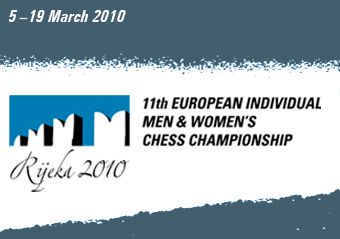 Nineteen-year-old Russian grandmaster Ian Nepomniachtchi and GM Pia Cramling of Sweden, who was a major force in women's chess before Nepomniachtchi was born, are the winners of the general and women's group respectively, both scoring 9 points out of a possible 11, in the 11th annual European Championships in the Croatian port city of Rijeka. Ian Alexandrovich, or "Nepo," as his fans call him, defeated veteran Armenian GM Vladimir Akopian in Wednesday's 11th and final round to cinch the title. Nepo took the lead in the ninth round when he took down Georgian GM Baadur Jobava, who was in sole possession of first place at the time. Ian Alexandrovich takes home his first European championship. Jobava finished second and Russian GM Artyom Timofeev took third. Pia entered the day a half point behind Lithuanian IM Vikotrija Cmilyte, who had held the lead since the ninth round when she defeated Poland's Monika Socko, who had held the lead since the early rounds. Pia defeated Ms. Cmilyte today in 74 moves in a game puctuated with errors due to mutual time trouble, which was often quite severe for Ms. Cmilyte. This is Pia's second European women's championship. She also won the 2003 title in Istanbul. For Ms. Cmilyte, it is the third time she has finished second. Mrs. Socko took third prize. Chuckie leads Amber Rapid/Blind  Ukranian grandmaster Vassily Ivanchuk leads the 19th annual Melody Amber Rapid/Blindfold Tournament in the city of Nice on the Mediterranean coast of France with 11 points after 8 rounds. Each round consists of two games: on played "blindfold", in which the players only see a computer screen displaying only an empty chess board and the opponent's last move, and the other a rapid game at a rate of 25 minutes with increments of 10 seconds a move for the entire game. "Chuckie," as his many fans affectionately refer to him, drew both his games against Cuban grandmaster Leinier Dom�nguez today. He got off to a good start on Wednesday by taking both games from the world's top-rated player, 19-year-old Magnus Carlsen of Norway. Ivanchuk also celbrated his 41st birthday Thursday by taking a point and a half from Dutch GM Jan Smeets in the fifth round. Magnus bounced back from his opening round setback by winning seven games in a row. Although he has only scored one point in the last two round, he is holding on to second place with former world champion Vladimir Kramnik and Israeli GM Boris Gelfand tied for third. Breaking down the two parts of the tournament, reining Russian national champion Alexander Grischuk leads the blindfold competition with 6 points (+4 -0 =4) while Ivanchuk leads in the rapid competition, also with 6 points (+4 -0 =4). Tomorrow is a rest day for the players. The 11-round event, one of the most unique in chess, runs through Thursday. 19th Melody Amber Rapid/Blind Tournament Standings after 8 Rounds . . . . . . . . . . . .---- Blindfold ---- ---- Rapid ----- .Total . . . . . . . . . . . . . .+ . - . =. . . . .+ . - . = . . .Points Vassily Ivanchuk. . . . . .2 . 0 . 6. . . . .4 . 0 . 4 . . . . 11. Magnus Carlsen. . . . . . .5 . 3 . 0. . . . .4 . 2 . 2 . . . . 10. Vladimir Kramnik. . . . . .4 . 3 . 1. . . . 4 . 2 . 1 . . . . .9� Boris Gelfand . . . . . . .3 . 2 . 3. . . . .4 . 2 . 1 . . . . .9� Sergey Karjakin . . . . . .4 . 3 . 1. . . . .3 . 2 . 3 . . . . .9. Alexander Grischuk. . . . .4 . 0 . 4. . . . .1 . 3 . 4 . . . . .9. Vugar Gashimov. . . . . . .2 . 2 . 4. . . . .3 . 2 . 3 . . . . .8� Peter Svidler . . . . . . .3 . 3 . 2. . . . .3 . 2 . 3 . . . . .8� Levon Aronian . . . . . . .2 . 4 . 2. . . . .3 . 3 . 1 . . . . .7. Ruslan Ponomariov . . . . .1 . 3 . 4. . . . .2 . 3 . 3 . . . . .6� Jan Smeets. . . . . . . . .1 . 3 . 4. . . . .0 . 6 . 2 . . . . .4. Leinier Dom�nguez . . . . .0 . 5 . 3. . . . .0 . 4 . 4 . . . . .3� Baden Baden holds narrow lead after 13 rounds in Bundesliga  The mighty team from Baden Baden continues to hold a narrow lead in the standings over Solingen by virtue of accumulating more individual points after a weekend of play in the Bundesliga, the German team chess league. Both Baden Baden and Solingen have 24 match points, but Baden Baden has 76 individual points to Solingen's 66. Baden Baden won both its matches in Emsdetten this weekend, defeating the home team in Round 12 on Saturday and taking down Wattenscheid in today's 13th round. Solingen spent the weekend in Berlin at the K�nig Tegel chess club and also went two-for-two, crushing the hapless K�nig Tegel team yesterday and the team from the Berlin Chess Federation today. Bremen began the weekend in a three-way tie for first place based only on match points, but fell out when the team could only draw a match against fourth-place M�lheim yesterday afternoon in Katernberg. In today's action, Bremen destroyed Katernberg, 7�-�. Bundesliga 2009-10 Season Standings after 13 Rounds . . . . . . . . .. . . . . . . . . . . Match. . Ind . . . . . . . . .+ . . . - . . . = . . .Pts . . Pts Baden-Baden. . .12 . . . 1 . . . 0 . . .24. . . 76. Solingen . . . .12 . . . 1 . . . 0 . . .24. . . 66. Bremen . . . . .10 . . . 0 . . . 3 . . .23. . . 67� M�lheim. . . . . 8 . . . 1 . . . 4 . . .20. . . 63� Wattenscheid . . 7 . . . 4 . . . 2 . . .16. . . 55� Hamburg. . . . . 7 . . . 5 . . . 1 . . .15. . . 57. Remagen. . . . . 7 . . . 5 . . . 1 . . .15. . . 56� Eppingen . . . . 6 . . . 5 . . . 2 . . .14. . . 55� Emsdetten. . . . 6 . . . 7 . . . 0 . . .12. . . 53� Trier. . . . . . 6 . . . 7 . . . 0 . . .12. . . 50� Katernberg . . . 6 . . . 7 . . . 0 . . .12. . . 45� Berlin . . . . . 2 . . . 8 . . . 3 . . . 7. . . 46� Munich . . . . . 1 . . . 9 . . . 3 . . . 5. . . 41. Heidelberg . . . 0 . . . 8 . . . 5 . . . 5. . . 35. K�nig Tegel. . . 0 . . .11 . . . 2 . . . 2. . . 32� Erfurt . . . . . 0 . . .11 . . . 2 . . . 2. . . 30. The next and final rounds will be played April 10 and 11 when Baden Baden will host M�lheim and Katernberg, Bremen will host Solingen on Saturday, April 10 in what will be a do-or-die match for both teams and play against Ramagen on Sunday while Solingen's other match in Bremen will be against Hamburg. Calendar Philadelphia Open 31 March-4 April. This replaces the Foxwoods Open after the Foxwoods Resort announced expected room rate hikes. Russian Team Championships, Dagomys 1-12 April. Bundesliga 0910, Rounds 14-15 (season finale), Erfurt, Eppingen, Bremen, Baden Baden. 10-11 April. Women's Grand Prix, Nalchik 23 April-6 May. Anand-Topalov Match for the World Title, Sofia 23 April-10 May. Bosna 2010, Sarajevo 5-14 May. Grand Prix, Astrakhan (Russia) 9-25 May. US Championship, St. Louis 13-25 May. Chicago Open 27-31 May. Women's Grand Prix, Jermuk 23 June-6 July. World Open, Valley Forge, Pennsylvania 29 June-5 July. Women's Grand Prix, Ulan Bator (Mongolia) 29 July-12 August. World Junior Championships, Chotowa Czarna (Poland) 2-17 August. Chess Olympiad, Khanty Mansiysk 19 September-4 October. European Club Cup, Plovdiv 16-24 October. Women's Grand Prix, Vina del Mar (Chile) 27 October-9 November. World Youth Championships, Halidiki (Greece) 19-31 October. FIDE Women's Knock Out (Women's World Championship), Turkey 2-25 December. |
| Printer Friendly | Permalink | | Top |
| Jack Rabbit
|
Sun Mar-21-10 03:04 PM Response to Original message |
| 1. This Week's Games |
|
Your humble hare acknowledges the assistance of Fritz 6.0 on analysis. Diagrams on the Jack Rabbit Chess Report are made with Chess M�rida, a true type font that can be downloaded free here. !""""""""# $tMvWlVmT% $OoOoOoOo% $ + + + +% $+ + + + % $ + + + +% $+ + + + % $pPpPpPpP% $RnBqKbNr% /(((((((() WHITE White to move (This position is a theoretical draw) I would like to thank my impressive and loyal staff: Buccaneer, Spitfire, Swashbuckler, Pancho and Robin Hood. |
| Printer Friendly | Permalink | | Top |
| Jack Rabbit
|
Sun Mar-21-10 03:05 PM Response to Reply #1 |
| 2. European Championships, Rijeka |
| Printer Friendly | Permalink | | Top |
| Jack Rabbit
|
Sun Mar-21-10 03:08 PM Response to Reply #2 |
| 4. Nepomniatchi - Jobava, Round 9 |
 Ian Nepomniachtchi Ian Nepomniachtchi - Baadur Jobava 11th European Championships (General Group), Round 9 Rijeka, 15 March 2010 Closed Caro-Kann Game: Fantasy Opening 1.e4 c6 2.d4 d5 3.f3 Qb6 4.a4!?
4...e5
5.dxe5 dxe4 6.a5 Qc7 7.f4
7...Nh6
8.Nc3 Bb4 9.Bd2 e3!
10.Bxe3 0-0 11.Nf3 Rd8 12.Bd3 Na6
13.Qe2 Bxa5 14.0-0 Nb4 15.Be4 Bf5 16.Kh1 Bb6
17.Bxb6 Qxb6 18.Ng5!?
18...c5!?
19.Rae1!
19...Qg6?!
20.Bxb7 Nxc2!?
!""""""""# $t+ T +l+% $Ob+ +oOo% $ + + +wM% $+ + PvN % $ + + P +% $+ N + + % $ Pm+q+pP% $+ + Rr+k% /(((((((() WHITE: Ian Nepomniachtchi Position after 20...Nb4c2:p 21.Nd5!
21...Rxd5
22.Bxd5 Bd3
23.Qf3 Re8
24.e6!?
24...Nxe1 25.Rxe1 fxe6?
!""""""""# $ + +t+l+% $O + + Oo% $ + +o+wM% $+ Ob+ N % $ + + P +% $+ +v+q+ % $ + + +pP% $+ + R +k% /(((((((() WHITE: Ian Nepomniachtchi Position after 25...fe6:p 26.Rxe6!
26...Kh8
27.h3 Rxe6 28.Bxe6 Bb5
29.f5 Qe8 30.f6 Qf8 31.f7 1-0
|
| Printer Friendly | Permalink | | Top |
| Jack Rabbit
|
Sun Mar-21-10 03:12 PM Response to Reply #2 |
| 5. Khurtsidze - Cramling, Round 9 |
|
Pia Cramling lost her fifth round game to Ketevan Arakhamia-Grant. In order to win the gold medal in Rijeka, she took 5� points out of her next six games.
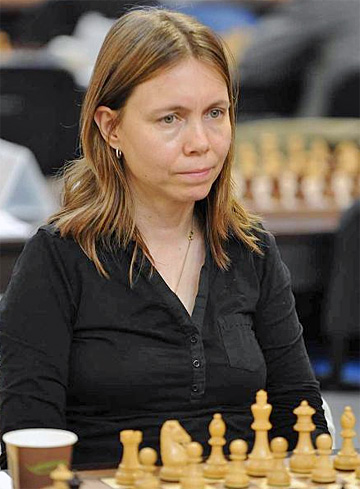 Pia Cramling Nini Khurtsidze - Pia Cramling 11th European Championships (Women's Group), Round 9 Rijeka, 15 March 2010 Slav Queen's Gambit: Tikhi Opening 1.d4 d5 2.c4 c6 3.e3
3...Bf5 4.cxd5 cxd5 5.Qb3 Qc7 6.Nc3
6...e6 7.Nf3 Nc6 8.Bd2 Nf6 9.Ne5
9...Nd7
10.Nxd7 Qxd7 11.Na4 Bd6!?
12.Rc1
12...Rb8 13.Nc5 Qe7 14.Bb5 0-0 15.0-0 Rfc8 16.Qa4 e5 17.Nxb7
17...Qxb7 18.Bxc6 Qxb2 19.dxe5 Qxe5 20.f4 Qe4
21.Qxa7 Rb2 22.Rf2 Qd3 23.Qd4?
!""""""""# $ +t+ +l+% $+ + +oOo% $ +bV + +% $+ +o+v+ % $ + Q P +% $+ +wP + % $pT B RpP% $+ R + K % /(((((((() WHITE: Nino Khurtsidze Position after 23.Qa7d4 23...Qxd4!!
24.exd4 Rxd2 25.Rxd2 Bxf4!
26.Rf2 Bxc1 27.Rxf5 Rxc6 !""""""""# $ + + +l+% $+ + +oOo% $ +t+ + +% $+ +o+r+ % $ + P + +% $+ + + + % $p+ + +pP% $+ V + K % /(((((((() WHITE: Nino Khurtsidze Position after 27...Rc8c6:B
28.Rxd5 Kf8 29.Kf1 Rc2 30.Ra5 Be3 31.d5 Ke7 32.Ra4 Kd6 0-1
|
| Printer Friendly | Permalink | | Top |
| Jack Rabbit
|
Sun Mar-21-10 03:16 PM Response to Reply #2 |
| 7. Jobava - Almasi, Round 8 |
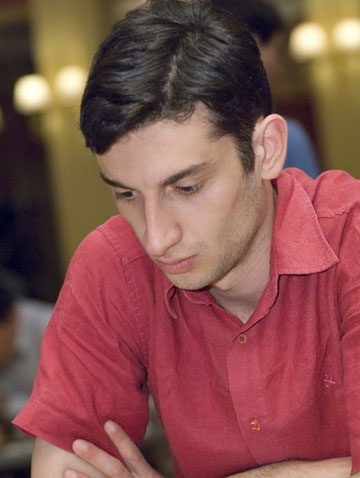 Baadur Jobava Baadur Jobava - Zoltan Almasi 11th European Championships (General Group), Round 8 Rijeka, 13 March 2010 East India Game: Queen's Indian Defense (Petrosian Opening) 1.d4 Nf6 2.c4 e6 3.Nf3 b6 4.a3 Bb7 5.Nc3 d5 6.cxd5 Nxd5 7.Bd2
7...Nd7 8.Qc2
8...c5
9.Nxd5
9...exd5
10.dxc5 Bxc5!?
11.e3
11...0-0 12.Bd3 Nf6 13.0-0 Ne4 14.Bb4
14...Qe7 15.Bxc5 bxc5 16.b4!?
16...cxb4! 17.axb4 Qxb4 18.Rfb1 Qe7 19.Nd4 g6!?
!""""""""# $t+ + Tl+% $Ov+ Wo+o% $ + + +o+% $+ +o+ + % $ + Nm+ +% $+ +vP + % $ +q+ PpP% $Rr+ + K % /(((((((() WHITE: Baadur Jobava Position after 19...g7g6 20.Bxe4!?
20...dxe4 21.Qb3
21...Rfc8 22.h4 Rc7 23.h5 Qg5 24.Qd1 a6 25.Rb6
25...Bc8!?
!""""""""# $t+v+ +l+% $+ T +o+o% $pR + +o+% $+ + + Wp% $ + No+ +% $+ + P + % $ + + Pp+% $R +q+ K % /(((((((() WHITE: Baadur Jobava Position after 25...Bb7c8 26.Qb1!
26...Bf5!?
27.h6 Rac8 28.Nxf5 gxf5 29.Qb2
29...Rd8 30.Rbxa6 Rcd7 31.g3 Qg4 32.Qf6 Rd1+ 33.Rxd1 Qxd1+ 34.Kh2 Qh5+ 35.Qh4
35...Qxh4+
36.gxh4 f4?!
!""""""""# $ + T +l+% $+ + +o+o% $r+ + + P% $+ + + + % $ + +oO P% $+ + P + % $ + + P K% $+ + + + % /(((((((() WHITE: Baadur Jobava Position after 36...f5f4 37.exf4!
37...Kf8
38.Kg3 Ke7
39.f5 Rd3+?
40.Kf4!
40...Rf3+ 41.Ke5 Rxf2
42.Ra7+ Ke8 43.Kf6 Kd8
!""""""""# $ + L + +% $R + +o+o% $ + + K P% $+ + +p+ % $ + +o+ P% $+ + + + % $ + + T +% $+ + + + % /(((((((() WHITE: Baadur Jobava Position after 43...Ke8d8 44.Ra4!
44...e3 45.Re4 e2 46.Kg7 Rxf5
47.Rxe2 Rf4 48.Kxh7 Rg4 49.Re5 f6 50.Re6 Kd7
51.Rxf6 Ke7 52.Rf5 Rxh4 53.Kg6 1-0
|
| Printer Friendly | Permalink | | Top |
| Jack Rabbit
|
Sun Mar-21-10 03:22 PM Response to Reply #2 |
| 9. Socko - Cmilyte, Round 9 |
|
Viktorija Cmilyte took over sole posession of first place from Monika Socko, who had held it from the early rounds, with this victory. She held it until defeated by Pia Cramling in the final round.
It is the third time that Ms. Cmilyte has finished in second place in the European women's championship. 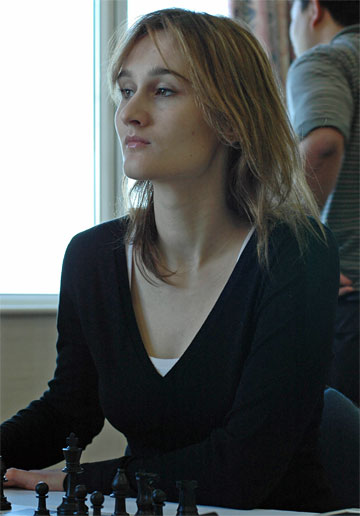 Viktorija Cmilyte Monika Socko - Viktorija Cmilyte 11th European Championships (Women's Group), Round 9 Rijeka, 15 March 2010 Spanish Petit Royal Game: Calabrian Defense (Schliemann Defense) 1.e4 e5 2.Nf3 Nc6 3.Bb5 f5
4.d3 fxe4 5.dxe4 Nf6 6.0-0 Bc5 7.Bxc6
7...bxc6 8.Nxe5 0-0 9.Bg5
9...Qe8 10.Bxf6 Rxf6 11.Nd3 Bd4 12.c3
12...Bb6 13.Nd2 d5!?
14.e5 Rf8 15.Kh1 Qg6 16.Nb3 Ba6 17.Nbc1 Rf5 18.Qd2
18...Raf8 19.a4?
19...Rh5!
20.Re1
20...Rff5 21.h3
21...Rf3!
22.Nf4
!""""""""# $ + + +l+% $O O + Oo% $vVo+ +w+% $+ +oP +t% $p+ + N +% $+ P +t+p% $ P Q Pp+% $R N R +k% /(((((((() WHITE: Monika Socko Position after 22.Nd3f4 22...Qh6!!
23.gxf3 Rxh3+ 24.Nxh3 Qxh3+ 25.Kg1 Qg3+ 26.Kh1 Bxf2!
27.Qxf2 Qxf2 28.Nb3 Qxf3+ 29.Kg1
!""""""""# $ + + +l+% $O O + Oo% $v+o+ + +% $+ +oP + % $p+ + + +% $+nP +w+ % $ P + + +% $R + R K % /(((((((() WHITE: Monika Socko Position after 29.Kh1g1 29...Be2!
30.Nd4 Qg3+ 31.Kh1 Bd3 32.e6 Be4+!
33.Rxe4
33...dxe4 34.Rf1 Qh4+
35.Kg2 Qg5+ 36.Kh3 e3
37.b4
!""""""""# $ + + +l+% $O O + Oo% $ +o+p+ +% $+ + + W % $pP N + +% $+ P O +l% $ + + + +% $+ + +r+ % /(((((((() WHITE: Monika Socko Position after 37...b2b4 37...c5! 38.bxc5
38...Qxc5 39.Kg2
39...g6 40.Rf3 Qe5 41.Nc2
41...e2 42.Kf2 Qxe6
43.Ke1 Qe4 0-1
|
| Printer Friendly | Permalink | | Top |
| Jack Rabbit
|
Sun Mar-21-10 03:23 PM Response to Reply #2 |
| 10. I. Sokolov - Z. Almasi, Round 11 |
|
Hungarian GM Zoltan Almasi came to Rijeka as the top seed. He had some rough going early on and then surged. By winning his last round game against Ivan Sokolov, he finished tied for fourth.
 Zoltan Almasi Zoltan Almasi - Ivan Sokolov 11th European Championships (General Group), Round 11 Rijeka, 17 March 2010 East India Game: Queen's Indian Defense (Petrosian Opening) 1.d4 Nf6 2.c4 e6 3.Nf3 b6 4.a3
4...Ba6 5.Qc2 Bb7
6.Nc3 c5 7.e4 cxd4 8.Nxd4 Bc5 9.Nb3 Nc6 10.Bf4
10...0-0
11.Bd3!?
11...e5
12.Bg5 h6!?
13.Bh4 Be7 14.0-0 d6
15.Rad1 Nd7 16.Bxe7 Qxe7
17.Nc1!?
17...Nd4!
18.Qb1
18...Nc5 19.N1e2 Nce6 20.Nxd4 Nxd4 21.Ne2 Ne6
22.Qc1 Rac8 23.Qe3 Qg5
24.b4 g6!?
!""""""""# $ +t+ Tl+% $Ov+ +o+ % $ O Om+oO% $+ + O W % $ Pp+p+ +% $P +vQ + % $ + +nPpP% $+ +r+rK % /(((((((() WHITE: Ivan Sokolov Position after 24...g7g6 25.f4!
25...exf4 26.Nxf4 Rfe8 27.Rf3!?
27...Nxf4!
28.Rxf4 Rc7 29.Rdf1 Bc8 30.R1f3 Kg7
31.Qf2 Be6 32.h3 Ree7 33.Bf1?
33...Qe5!
34.Be2
34...Qb2 35.Kh1
!""""""""# $ + + + +% $O T ToL % $ O Ov+oO% $+ + + + % $ Pp+pR +% $P + +r+p% $ W +bQp+% $+ + + +k% /(((((((() WHITE: Ivan Sokolov Position after 35.Kg1h1 35...Bxc4!
36.e5
36...Qxe2 0-1
|
| Printer Friendly | Permalink | | Top |
| Jack Rabbit
|
Sun Mar-21-10 03:28 PM Response to Reply #2 |
| 11. I. Sokolov - Caruana, Round 7 |
|
Ivan Sokolov has had a good run as of late. He took home the trophy in the Reykjavik Open in early March and made a serious go at the European Championships last week.
Ivan Sokolov Ivan Sokolov - Fabiano Caruana 11th European Championships (General Group), Round 7 Rijeka, 12 March 2010 Semi-Slav Queen's Gambit: Catalan Opening 1.d4 d5 2.c4 c6 3.Nc3 Nf6 4.Nf3 e6 5.g3 Nbd7 6.Bg2 dxc4 7.a4
7...Bb4 8.0-0 0-0 9.Qc2 Qe7 10.Bf4
10...a5
11.e4 b6 12.Rfe1 h6 13.d5
13...cxd5!?
14.exd5
14...Bxc3 15.d6 Qd8 16.Qxc3 Bb7
17.Qxc4 Rc8 18.Qe2
18...Nd5 19.Rad1
19...Nxf4 20.gxf4 Nf6
21.f5 Re8 22.Ne5 Bxg2 !""""""""# $ +tWt+l+% $+ + +oO % $ O PoM O% $O + No+ % $p+ + + +% $+ + + + % $ P +qPvP% $+ +rR K % /(((((((() WHITE: Ivan Sokolov Position after 22...Bb7g2:B 23.Nxf7!?
23...Kxf7?!
24.fxe6+ Kg8 25.Kxg2 Rc5 26.Qf3 Kh8?!
!""""""""# $ + Wt+ L% $+ + + O % $ O PpM O% $O T + + % $p+ + + +% $+ + +q+ % $ P + PkP% $+ +rR + % /(((((((() WHITE: Ivan Sokolov Position after 26...Kg8h8 27.d7!
27...Re7
28.Rd6!
28...Nxd7
29.Red1 Rg5+
30.Kf1!
30...Qf8 31.exd7 Qxf3 32.d8Q+ Kh7 33.Qxe7
33...Rf5 34.Qh4 Re5
!""""""""# $ + + + +% $+ + + Ol% $ O R + O% $O + R + % $p+ + + Q% $+ + +w+ % $ P + P P% $+ +r+k+ % /(((((((() WHITE: Ivan Sokolov Position after 34...Rf5e5 35.Rxh6+!!
35...gxh6 36.Rd7+ Kg6 37.Rd6+ Kf7 38.Qc4+!
38...Ke8
39.Re6+ Rxe6 40.Qxe6+ Kd8 41.Qxb6+ !""""""""# $ + L + +% $+ + + + % $ Q + + O% $O + + + % $p+ + + +% $+ + +w+ % $ P + P P% $+ + +k+ % /(((((((() WHITE: Ivan Sokolov Position after 41.Qe6b6:p
41...Kc8 42.Qc5+ Kb7 43.Qb5+ Kc8 44.Qc4+ Kb7 45.h4 h5
46.Qd4 Kb8 47.Kg1 Kb7 48.Kh2 Ka8 !""""""""# $l+ + + +% $+ + + + % $ + + + +% $O + + +o% $p+ Q + P% $+ + +w+ % $ P + P K% $+ + + + % /(((((((() WHITE: Ivan Sokolov Position after 48...Kb7a8 49.Qh8+
49...Kb7 50.Qg7+ Kb6 51.Qh6+ Kb7 52.Qe3 Qg4
53.Qe7+ Kb6 54.Qf6+ Kb7 55.b3 Qd1 56.Qf7+ Kc6
57.Qc4+ Kd7 58.Kg2 Kd8
59.Qg8+ Ke7 60.Qg5+ Kf7 61.Qf5+ Kg8
62.Qf3 Qc2 63.Qxh5 Qxb3 64.Qxa5 Qb7+ 65.f3 Qb2+ 66.Kh3 1-0
|
| Printer Friendly | Permalink | | Top |
| Jack Rabbit
|
Sun Mar-21-10 03:29 PM Response to Reply #2 |
| 12. Inarkiev - Lysyj, Round 10 |
|
Igor Lysyj is a fine Russian grandmaster who, like many fine Russian grandmasters, is overshadowed by other Russian grandmasters.
He finished tied for fourth, equal with defending champion Tomashevsky.  Igor Lysyj Ernesto Inarkiev - Igor Lysyj 11th European Championships (General Group), Round 10 Rijeka, 16 March 2010 Closed French Game: Steinitz Opening 1.e4 e6 2.d4 d5 3.Nc3 Nf6 4.e5 Nfd7 5.f4 c5 6.Nf3 Nc6 7.Be3 a6 8.Qd2 b5 9.dxc5
9...Bxc5 10.Ne2
10...Qb6
11.Bxc5 Nxc5 12.Ned4 Bd7!?
13.Nxc6 Bxc6
14.Nd4 0-0 15.Bd3 f6 16.exf6 Rxf6
!""""""""# $t+ + +l+% $+ + + Oo% $oWv+oT +% $+oMo+ + % $ + N P +% $+ +v+ + % $oOow +pP% $R + K +r% /(((((((() WHITE: Ernesto Inarkiev Position after 16...Rf8f6:p 17.0-0-0!?
17...Be8
18.Rhf1 Rc8 19.g4!?
19...Qd6!
20.Kb1
20...Nxd3 21.cxd3
21...Bd7!
22.Ne2!?
22...Rcf8
23.Rg1 d4 24.h4 Bc6 25.Rdf1
25...b4
26.h5 a5 27.Rf2 a4 28.Rgf1
28...a3!?
!""""""""# $ + + Tl+% $+ + + Oo% $ +vWoT +% $+ + + +p% $ O O Pp+% $O +p+ + % $pP QmR +% $+ + +r+ % /(((((((() WHITE: Ernesto Inarkiev Position after 29.a2a3 29.b3!
29...R6f7 30.Ng3
30...Bd5
31.h6
31...g6 32.Ne2 Bb7 33.f5!?
33...exf5!
34.gxf5 !""""""""# $ + + Tl+% $+v+ +t+o% $ + W +oP% $+ + +p+ % $ O O + +% $Op+p+ + % $p+ QmR +% $+k+ +r+ % /(((((((() WHITE: Ernesto Inarkiev Position after 34...gf5:p 34...Bc8!
35.f6 Bf5 36.Rf3 Rxf6
37.Nc1 Qc5 38.Qe2 Rc8 39.Qd2
39...Qc3 40.Qxc3 Rxc3 41.Rf4 Rd6
42.Re1 Kf7!?
43.Ree4
43...Kf6
44.Rxd4 Rxd4 45.Rxd4 !""""""""# $ + + + +% $+ + + +o% $ + + L P% $+ + +vO % $ O R + +% $OpTp+ + % $p+ + + +% $+kN + + % /(((((((() WHITE: Ernesto Inarkiev Position after 45.Rf4d4:R 45...g5!
46.Rxb4 g4!
47.Rf4 Kg5 48.Rf2 Bg6 49.b4
49...Kxh6
50.b5 Rc5 51.Rh2+ Kg5 52.b6 Rb5+ 53.Kc2 Rxb6 54.Kc3
54...h5 55.Ne2 Rb2 56.d4 Rxa2 57.Kb3 Rd2 58.Kxa3 Bd3! 0-1
|
| Printer Friendly | Permalink | | Top |
| Jack Rabbit
|
Sun Mar-21-10 03:33 PM Response to Reply #2 |
| 13. Stefanova - Zhukova, Round 9 |
|
Former world women's champion Eti Stefanova of Bulgaria came to Rijeka as the the top seed in the women's group. She finished tied for fourth
Antoaneta Stefanova Antoaneta Stefanova - Natalia Zhukova 11th European Championships (Women's Group), Round 9 Rijeka, 15 March 2010 Open Queen's Gambit: Catalan Opening 1.d4 d5 2.c4 e6 3.Nf3 Nf6 4.g3 dxc4 5.Bg2 c5 6.0-0 cxd4
7.Qxd4
7...Qxd4 8.Nxd4 a6 9.Nd2 Bc5 10.Nc2 Nd5!?
11.Nxc4
11...Bd7
12.b4 Ba7 13.e4 Nb6?!
14.Nd6+! Ke7 15.Nxb7!
15...Rc8 16.Ne3 Na4 17.Rd1
17...Nc3 18.Rd2 Bd4?
!""""""""# $tMt+ + +% $+n+vLoOo% $o+ +o+ +% $+ + + + % $ P Vp+ +% $+ M N P % $p+ R PbP% $R B + K % /(((((((() WHITE: Antoaneta Stefanova Position after 18...Ba7d4 19.Bb2!
19...Nc6
20.Re1 Rc7 21.Nd5+ exd5
22.exd5+ Be6 23.d6+ 1-0
|
| Printer Friendly | Permalink | | Top |
| Jack Rabbit
|
Sun Mar-21-10 03:06 PM Response to Reply #1 |
| 3. Amber Rapid/Blind Tournament, Nice |
|
Edited on Sun Mar-21-10 03:15 PM by Jack Rabbit
 Nice: Night View with Blurred Cars |
| Printer Friendly | Permalink | | Top |
| Jack Rabbit
|
Sun Mar-21-10 03:15 PM Response to Reply #3 |
| 6. Ivanchuk - Carlsen, Rapid Competition, Round 1 |
|
Edited on Sun Mar-21-10 03:20 PM by Jack Rabbit
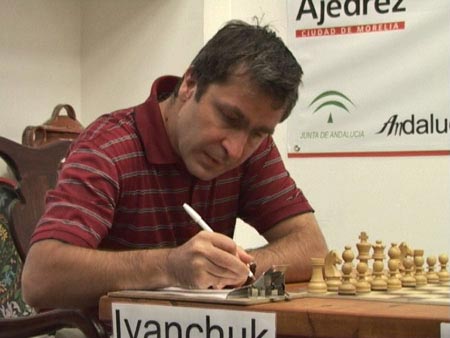 Vassily Ivanchuk Vassily Ivanchuk - Magnus Carlsen Melody Amber Tournament (Rapid Competition), Round 1 Nice, 13 March 2010 Open Sicilian Game: Najdorf-Scheveninger Defense (Rauzer Opening/Poisoned Pawn Variation) 1.e4 c5 2.Nf3 d6 3.d4 cxd4 4.Nxd4 Nf6 5.Nc3 a6 6.Be3 Ng4 7.Bc1 Nf6 8.Bg5 e6 9.f4 Qb6 10.Qd2 Qxb2 11.Rb1 Qa3
12.f5
12...Nc6 13.fxe6 fxe6 14.Nxc6 bxc6 15.Be2
15...Be7 16.0-0 0-0 17.Kh1
17...Ra7 18.Qe3 Rd7 19.Rb8!?
!""""""""# $ Rv+ Tl+% $+ +tV Oo% $o+oOoM +% $+ + + B % $ + +p+ +% $W N Q + % $p+p+b+pP% $+ + +r+k% /(((((((() WHITE: Vassily Ivanchuk Position after 19.Rb1b8 19...Kh8
20.e5 dxe5
21.Ne4 Qxe3
22.Bxe3 Rdd8 23.Bc5 Bxc5 24.Nxc5 Kg8 25.Bc4 Kf7
26.Rb6 Rd4!?
27.Bxe6+ Ke7
!""""""""# $ +v+ T +% $+ + L Oo% $oRo+vM +% $+ N O + % $ + T + +% $+ + + + % $p+p+ +oO% $+ + +r+l% /(((((((() WHITE: Vassily Ivanchuk Position after 27...Kf7e7 28.Rxc6!
28...Nd7
29.Re1
29...Nxc5 30.Bxc8 Re4
31.Rc1 Rc4 32.Bxa6 Rc3!
33.Bb5
33...Ne4 34.a4 Rxc6?!
!""""""""# $ + + T +% $+ + L Oo% $ +t+ + +% $+b+ O + % $p+ +m+ +% $+ + + + % $ +p+ +pP% $+ R + +k% /(((((((() WHITE: Vassily Ivanchuk Position after 34...Rc3c6:R 35.Bxc6!
35...Nc3 36.a5!
36...Kd6 37.Bb7 Kc7 38.a6 e4 39.Re1 Kb6?
!""""""""# $ + + T +% $+b+ + Oo% $pL + + +% $+ + + + % $ + +o+ +% $+ M + + % $ +p+ +pP% $+ + R +k% /(((((((() WHITE: Vassily Ivanchuk Position after 39...Kc7b6 40.Kg1!
40...Rf5
41.Bxe4 Nxe4 42.Rxe4 Kxa6
43.Re7 Rg5 44.Kf2 Kb6
45.Kf3 h5 46.h4 Rf5+ 47.Ke4 Rc5
48.g3 Rc4+ 49.Kf5 g6+ 1-0
|
| Printer Friendly | Permalink | | Top |
| Jack Rabbit
|
Sun Mar-21-10 03:20 PM Response to Reply #3 |
| 8. Aronian - Carlsen, Blindfold Competition, Round 2 |
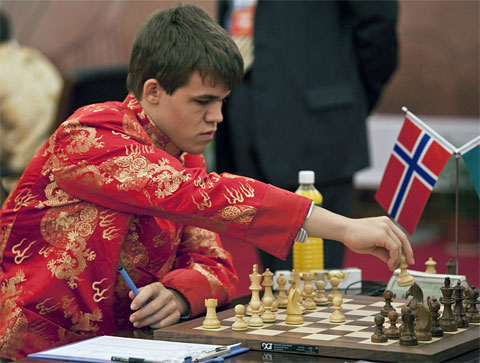 Magnus Carlsen Levon Aronian - Magnus Carlsen Melody Amber Tournament (Blindfold Competition), Round 2 Nice, 14 March 2010 West India Game: King's Indian Defense (Main Line) 1.Nf3 Nf6 2.c4 g6 3.Nc3 Bg7 4.e4 d6 5.d4 0-0 6.Be2 e5 7.0-0 Nc6 8.d5 Ne7 9.Ne1
9...Nd7
10.Nd3
10...f5 11.Bd2 Nf6 12.f3 Kh8
13.g4
13...c6 14.Kg2
14...b5!?
15.b3
15...a5
16.Nf2
16...b4!
17.Na4 Bb7!?
18.Rc1
18...fxe4 19.fxe4 cxd5 20.exd5
!""""""""# $t+ W T L% $+v+ M Vo% $ + O Mo+% $O +pO + % $nOp+ +p+% $+p+ + + % $p+ BbNkP% $+ Rq+r+ % /(((((((() WHITE: Levon Aronian Position after 20...ed5:p 20...Nexd5!?
21.cxd5 Nxd5
22.Kg1!
22...e4
23.Nxe4 Bd4+ 24.Rf2
24...Rxf2 25.Nxf2?
!""""""""# $t+ W + L% $+v+ + +o% $ + O +o+% $O +m+ + % $nO V +p+% $+p+ + + % $p+ BbN P% $+ Rq+ K % /(((((((() WHITE: Levon Aronian Position after 24.Ne4f2:R 25...Qh4!
26.Qe1
26...Rf8 27.Bf3 Rxf3 28.Qe4 Qxf2+ 0-1
|
| Printer Friendly | Permalink | | Top |
| Jack Rabbit
|
Wed Mar-24-10 06:48 PM Response to Original message |
| 14. Updates (Wednesday) |
|
Magnus takes lead in Nice
 Norwegian grandmaster Magnus Carlsen, the world's top rated chess player, took the lead today in the 19th annual Melody Amber Rapid/Blindfold Tournament in the city of Nice on the Mediterranean coast of France when defeated Ukrainian GM Ruslan Panomariov in two game, one blindfold and the other rapid, while Ukrainian GM Vassily Ivanchuk and former world champion Vladimir Kramnik of Russia battled to a pair of draws. Ivanchuk entered the day in first place, a position he has held since taking two game from Magnus in the tournament's opening round. After today's action, Magnus was a half-point ahead of Ivanchuk. The final round takes place tomorrow at 12:30 pm in Nice (4:30 am PDT) on the official tournament website. Magnus will play first a blindfold and then a rapid game against Kramnik, who is in third place one point behind Magnus. Ivanchuk will play against Israeli GM and World Cup champion Boris Gelfand. Russian IM Elena Tairova, 18, dies From ChessBase.com Posted online Wednesday, March 24 IM/WGM Elena Tairova passes at eighteen 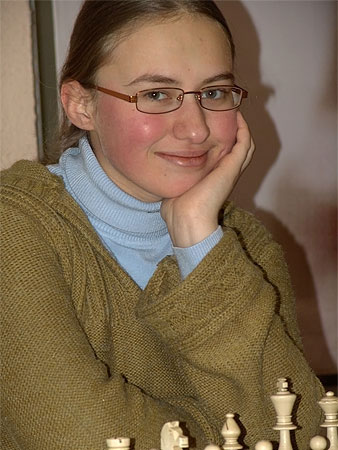 Very sad news from Russia: the talented young player Elena Tairova, born on August 28 1991, has died at the age of just 18. Elena became a WGM at just 14 years of age, and a full IM the following year. She won a succession of European and World girls� junior titles, and in 2006 was the Russian women�s under-20 champion. We offer our deepest condolences to her family and friends. Read more at the link. |
| Printer Friendly | Permalink | | Top |
| Jack Rabbit
|
Thu Mar-25-10 12:49 AM Response to Reply #14 |
| 15. Correction on tomorrow's games in Nice |
|
Magnus Carlsen will play against Alexander Grischuk tomorrow.
Vladimir Kramnik will be opposed by Sergey Karjakin. As stated, Vassily Ivanchuk will meet Boris Gelfand. |
| Printer Friendly | Permalink | | Top |
| Jack Rabbit
|
Thu Mar-25-10 12:25 PM Response to Original message |
| 16. Update (Thusday): Chuckie, Magnus tied at top as Amber Rapid/Blind concludes |
|
Vassily Ivanchuk takes tournament championship on tiebreaks.
19th Melody Amber Rapid/Blind Tournament Final Standings . . . . . . . . . . . .---- Blindfold ---- ---- Rapid ----- .Total -------- . . . . . . . . . . . . . .+ . - . =. . . . .+ . - . = . . .Points -----SB- Vassily Ivanchuk. . . . . .2 . 0 . 9. . . . .5 . 0 . 6 . . . . 14� . . 158� Magnus Carlsen. . . . . . .6 . 4 . 1. . . . .7 . 2 . 2 . . . . 14� . . 142� Vladimir Kramnik. . . . . .5 . 3 . 3. . . . 5 . 3 . 3 . . . . 13. . . 137� Alexander Grischuk. . . . .6 . 1 . 4. . . . .2 . 4 . 5 . . . . 12� . . 123� Sergey Karjakin . . . . . .4 . 4 . 3. . . . .4 . 2 . 5 . . . . 12. . . 120� Vugar Gashimov. . . . . . .2 . 2 . 7. . . . .3 . 2 . 5 . . . . 11� . . 120� Boris Gelfand . . . . . . .3 . 2 . 6. . . . .4 . 4 . 3 . . . . 11� . . 116� Peter Svidler . . . . . . .3 . 3 . 5. . . . .4 . 3 . 4 . . . . 11� . . 115� Levon Aronian . . . . . . .4 . 5 . 2. . . . .4 . 3 . 4 . . . . 11. . . 108� Ruslan Ponomariov . . . . .2 . 4 . 5. . . . .3 . 5 . 3 . . . . .9. . . .92� Jan Smeets. . . . . . . . .1 . 4 . 6. . . . .1 . 8 . 2 . . . . .6. . . .61� Leinier Dom�nguez . . . . .0 . 6 . 5. . . . .0 . 6 . 5 . . . . .4� . . .57� |
| Printer Friendly | Permalink | | Top |
| madinmaryland
|
Tue Jul-27-10 02:44 PM Response to Original message |
| 17. Kicking for Jack Rabbit! |
| Printer Friendly | Permalink | | Top |
| DU
AdBot (1000+ posts) |
Sat Jan 04th 2025, 09:41 PM Response to Original message |
| Advertisements [?] |
| Top |
| Home » Discuss » Topic Forums » Sports |
|
Powered by DCForum+ Version 1.1 Copyright 1997-2002 DCScripts.com
Software has been extensively modified by the DU administrators
Important Notices: By participating on this discussion board, visitors agree to abide by the rules outlined on our Rules page. Messages posted on the Democratic Underground Discussion Forums are the opinions of the individuals who post them, and do not necessarily represent the opinions of Democratic Underground, LLC.
Home | Discussion Forums | Journals | Store | Donate
About DU | Contact Us | Privacy Policy
Got a message for Democratic Underground? Click here to send us a message.
© 2001 - 2011 Democratic Underground, LLC